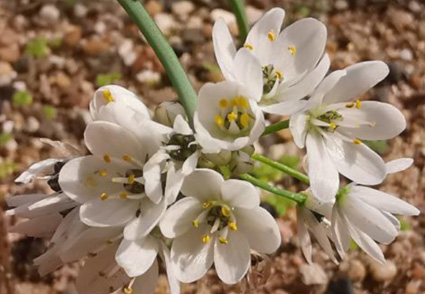Abstract
Allium ruhmerianum Ascherson ex Durand et Barratte, an endemic Allium species from Cyrenaica, was examined using anatomical, cytological, and molecular methods to determine its relationship and position within the genus Allium taxonomy. The previously published chromosome number 2n=33 was not confirmed; we counted 2n=14 in all three accessions examined. In conjunction with cytological and anatomical results, the molecular data placed A. ruhmerianum in the Molium section, close to A. neapolitanum and A. palaestinum. These results render the A. section Rynchocarpum Brullo superfluous.
References
- Altinordu, F., Peruzzi, L., Yu, Y. & He, X. (2016) A tool for the analysis of chromosomes: KaryoType. Taxon 65: 586–592. https://doi.org/10.12705/653.9
- Bartolo, G., Brullo, S., Pavone, P. & Terrasi, M.C. (1984) Cytotaxonomical notes on some «Liliaceae» of N Cyrenaica. Webbia 38: 601–622. https://doi.org/10.1080/00837792.1984.10670329
- Blattner, F. (1999) Direct amplification of the entire ITS region from poorly preserved plant material using recombinant PCR. Biotechniques 27: 1180–1186. https://doi.org/10.2144/99276st04
- Dariba, D., Taboada, G.L., Doallo, R. & Posada, D. (2012) jModelTest 2: more models, new heuristics and parallel computing. Nature Methods 9: 772. https://doi.org/10.1038/nmeth.2109
- Cirillo, D. (1788) Plantarum Rariorum regni Neapolitani fasciculus primus. Fasc. 1.
- Durand, E., Barratte, G., Ascherson, P., Barbey, W. & Muschler, R. (1910) Catalogue Raisonne Plantes de Tripolitaine. Geneve.
- Felsenstein, J. (1985) Confidence limits on phylogenies: an approach using the bootstrap. Evolution 39: 783–791. https://doi.org/10.2307/2408678
- Fragman-Sapir, O. & Friesen, N. (2017) Allium palaestinum—a forgotten species from Israel is re-described. Israel Journal of Plant Sciences 64 (1–2): 64–70. https://doi.org/10.1080/07929978.2016.1255029
- Friesen, N. (2022) Chapter 1. Introduction to Edible Alliums: Evolution, Classification and Domestication. In: Rabinowich, H.D. & Thomas, B. (Eds.) Edible Allium: Botany, Production and Uses. CAB International.
- Friesen, N., Fritsch, R.M. & Blattner, F.R. (2006) Phylogeny and new intrageneric classification of Allium (Alliaceae) based on nuclear ribosomal DNA ITS sequences. Aliso 22: 372–395. https://doi.org/10.5642/aliso.20062201.31
- Friesen, N., Smirnov, S.V., Leweke, M., Seregin, A.P. & Fritsch, R.M. (2021) Taxonomy and phylogenetics of Allium section Decipientia (Amaryllidaceae): Morphological characters do not reflect the evolutionary history revealed by molecular markers. Botanical Journal of the Linnean Society 197: 190–228. https://doi.org/10.1093/botlinnean/boab023
- Friesen, N., Herden, T., Leweke, M., Grützmacher, L., Fragman-Sapir, O., Hurka, H., Blattner, F.R. & Fritsch, R.M. (2024) Dated phylogeny, phylogeography, and classification of Allium subgenus Amerallium (Amaryllidaceae) from the Old World, based on six DNA fragments. Taxon 73 (4): 971–991. https://doi.org/10.1002/tax.13217
- Fritsch, R.M. (1988) Anatomische Untersuchungen an der Blattspreite bei Allium L. (Alliaceae) I. Arten mit einer einfachen Leitbündelreihe. Flora 181: 83–100. https://doi.org/10.1016/S0367-2530(17)30354-7
- Hanelt, P., Schultze-Motel, J., Fritsch, R., Kruse, J., Maaß, H.I., Ohle, K. & Pistrick, K. (1992) Infrageneric grouping of Allium—the Gatersleben approach. In: Hanelt, P., Hammer, K. & Knupffer, H. (eds.) The Genus Allium—Taxonomic Problems and Genetic Resources. Proceeding of an International Symposium held at Gatersleben, Germany, June 11–13, 1991. Gatersleben: IPK. pp. 107–123.
- Klaas, M. & Friesen, N. (2002) Molecular markers in Allium. In: Rabinowitch, H.D. & Currah, L. (Eds.) Allium crop science: Recent advances. Wallingford: CABI, pp. 159–185. https://doi.org/10.1079/9780851995106.0159
- Kluge, A.G. & Farris, J.S. (1969) Quantitative phyletics and the evolution of anurans. Systematic Zoology 18: l–32. https://doi.org/10.1093/sysbio/18.1.1
- Kumar, S., Stecher, G. & Tamura, K. (2016) MEGA 7: Molecular Evolutionary Genetic Analysis version 7.0 for bigger datasets. Molecular Biology and Evolution 33: 1870–1874. https://doi.org/10.1093/molbev/msw054
- Levan, A., Fredga, K. & Sandberg, A.A. (1964) Nomenclature for centromeric position on chromosomes. Hereditas 52: 201–220. https://doi.org/10.1111/j.1601-5223.1964.tb01953.x
- Maire, R. (1958) Flore de L’Afrique du Nord. Vol. 5. Monocotyledonae: Liliales. Liliaceae. Paris.
- Khan, N., Friesen, N., Sultan, A., Fritsch, R.M., Khan, T. & Ishaq, K. (2022) Allium sulaimanicum—a new Allium species and section from Pakistan. Frontiers in Plant Science 13: 1020440. https://doi.org/10.3389/fpls.2022.1020440
- Oxelman, B., Liden, M. & Berglund, D. (1997) Chloroplast rps16 intron phylogeny of the tribe Sileneae (Caryophyllaceae). Plant Systematics and Evolution 206: 393–410. https://doi.org/10.1007/BF00987959
- POWO Plants of the World Online. (2024) Available from: https://powo.science.kew.org (accessed 1 April 2024)
- Ronquist, F. & Huelsenbeck, J.P. (2003) MrBayes 3: Bayesian phylogenetic inference under mixed models. Bioinformatics 19: 1572–1574. https://doi.org/10.1093/bioinformatics/btg180
- Smirnov, Y.A. (1968) Accelerated method of study of somatic chromosomes of fruit plants. Tsitologiya (Moskva) 10: 1601–1602. [In Russian]
- Stearn, W.T. (1978) European species of Allium and allied genera of Alliaceae: A synonymic enumeration. Annals of the Museum Goulandris 4: 83–198.
- Swofford, D.L. (2002) PAUP*: Phylogenetic analysis using parsimony (*and other methods), version 4.0b10. Sunderland, Ma: Sinauer.
- Taberlet, P., Gielly, L., Pautou, G. & Bouvet, J. (1991) Universal primers for amplification of three non-coding regions of chloroplast DNA. Plant Molecular Biology 17: 1105–1109. https://doi.org/10.1007/BF00037152
- Thompson, J.D., Gibson, T.J., Plewniak, F., Jeanmougin, F. & Higgins, D.G. (1997) The Clustal X window interface: flexible strategies for multiple sequence alignment aided by quality analysis tools. Nucleic Acids Research 25: 4876–4882. https://doi.org/10.1093/nar/25.24.4876
- Tzanoudakis, D. (1986) Karyotype Variation in Allium Sect. Molium G. Don from Greece. Caryologia 39 (1): 69–88, https://doi.org/10.1080/00087114.1986.10797769
- de Wilde-Duyfjes, B.E.E. (1976) A revision of the genus Allium L. (Liliaceae) in Africa. Mededelingen (Landbouwhogeschool Wageningen) 76 (11): 1–237. [https://edepot.wur.nl/200358]
- White, T.J., Bruns, T., Lee, S. & Taylor, J. (1990) Amplification and direct sequencing of fungal ribosomal RNA genes for phylogenetics. In: PCR Protocols: A Guide to Methods and Applications. Academic Press: New York, NY, USA, pp. 315–322. https://doi.org/10.1007/BF00224530
- Ved Brat, S. (1965) Genetic system in Allium. I. Chromosome variation. Chromosoma 16: 486–499. https://doi.org/10.1007/BF00343176


